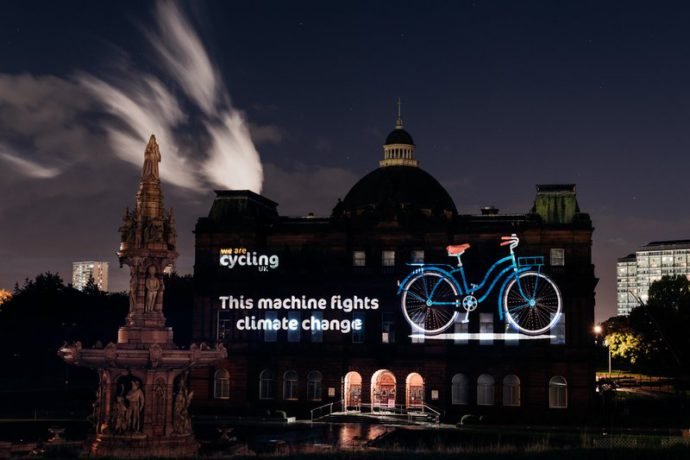‘cycle fights climate change’ projections in glasglow ahead of cop26

Meet the machine that “fights climate change” lights up iconic locations in Glasglow, an idyllic city known as Scotland’s cultural capital, in the run-up to COP26 summit. Glasglow will be the epicentre of the 26th Conference of the Parties (CoP26) to the United Nations Framework Convention on Climate Change (UNFCCC) which kicks off on October 31, 2021.
Glasglow is a destination rich in history and heritage, stunning architecture, scenic beauty, cultural activity, and entertainment.
Cycling rejuvenation across the globe stores the secret of planet health. The cycle messaging projections beamed onto locations including the Barras Market, People’s Palace and Kingston Bridge in Glasglow. The unique initiative was coordinated by charity Cycling UK to send a message to political leaders ahead of COP26. The stunning light projections highlight cycling’s role in fighting climate change, and Scotland’s unique connection to cycling as the birthplace of the bicycle.

More than 30,000 delegates and 120 world leaders will descend in Glasglow for COP 26 to discuss, deliberate and take conscious decisions to battle the dire climate emergency that stares us in the face. The IPCC climate change report has ringed the bell globally on the threat posed to the survival of the planet earth.
The report highlights that heatwaves, droughts, and other extreme weather events will be the new normal across India and South Asia. UN Secretary-General António Guterres has sounded “Code Red for humanity” based on the findings of climate scientists.
“If we combine forces now, we can avert climate catastrophe. But, as today’s report makes clear, there is no time for delay and no room for excuses. I count on government leaders and all stakeholders to ensure COP26 is a success.”
UN Secretary-General António Guterres
IPCC report key points for COP26
The report mention that “it is unequivocal that human influence has warmed the atmosphere, ocean and land. Widespread and rapid changes in the atmosphere, ocean, cryosphere and biosphere have occurred.

- Global surface temperature was 1.09C higher in the decade between 2011-2020 than between 1850-1900.
- The past five years have been the hottest on record since 1850
- The recent rate of sea level rise has nearly tripled compared with 1901-1971
- Human influence is “very likely” (90%) the main driver of the global retreat of glaciers since the 1990s and the decrease in Arctic sea-ice
- It is “virtually certain” that hot extremes including heatwaves have become more frequent and more intense since the 1950s, while cold events have become less frequent and less severe.
About UNFCC & COP26 relationship
The United Nations Framework Convention (UNFCCC) was established at the first Rio Earth Summit in 1992, the sister Convention to the Convention on Biodiversity. A short history and timeline of the UNFCCC, including the Rio Summit, the Kyoto Protocol and the Paris Climate Change Agreement is presented here.
The UNFCCC has over 200 countries who are ‘party’ to the Convention. The Parties to the Convention meet every year (with the exception of 2020 due to Covid-19) at the Conference of the Parties (COP). The meeting of the UNFCCC in Glasgow in November 2021 will be COP26.
The UNFCCC established agreements between the Parties to act on climate change. The first agreement was the Kyoto Protocol, which sets binding emission reduction targets for 36 industrialised countries and the European Union. Overall, these targets add up to an average of 5 per cent emission reduction compared to 1990 levels over the five-year period of 2008–2012.
The second phase ran from 2013 to 2020, with Parties committing to reduce GHG emissions by at least 18 per cent below 1990 levels; however, fewer countries made commitments to this second phase. The USA was notably absent from both phases of the Kyoto Protocol.
Invest in cycle & don’t reinvent the wheel in COP26
The cycle projections highlight that urgent investment in cycling and other modes of active travel is key to decarbonising transport and tackling climate change.
On the campaign to promote cycling, Duncan Dollimore, Cycling UK’s head of campaigns and advocacy said, “It’s appropriate to shine a spotlight on cycling’s role in fighting climate change in Glasgow. This humble machine’s origins 182 years ago were just 70 miles from where the world’s leaders gather next week in Glasgow to decide the future of us all – its role in this fight should not be underestimated.
“Investment in cycling can help to save our planet, but time is running out. At the current rate of reduction, it would take 600 years to reduce the UK’s transport emissions to zero. Cycling can play a key role in decarbonising transport, but urgent action and investment are essential to enable more people to cycle.”
As per cycling UK, only 18% of the world’s population owns a car, so COP 26 focus on electric vehicles looks like it will benefit people in rich nations rather than those affected most by climate change and least able to afford a bike or public transport.
They are demanding that COP delegates agree that all countries need to invest in this proven low-carbon technology by creating a safe cycling infrastructure that will enable more people to cycle for everyday journeys.

